Reading time for children: 18 min
The brother took his sister’s hand and said to her, „Since our mother died we have had no good days. Our stepmother beats us every day, and if we go near her she kicks us away. We have nothing to eat but hard crusts of bread left over. The dog under the table fares better,“ he gets a good piece every now and then. If our mother only knew, how she would pity us! Come, let us go together out into the wide world!“
So they went, and journeyed the whole day through fields and meadows and stony places, and if it rained the sister said, „The skies and we are weeping together.“ In the evening they came to a great wood, and they were so weary with hunger and their long journey, that they climbed up into a high tree and fell asleep. The next morning, when they awoke, the sun was high in heaven, and shone brightly through the leaves.
Then said the brother, „Sister, I am thirsty. If I only knew where to find a brook, that I might go and drink! I almost think that I hear one rushing.“ So the brother got down and led his sister by the hand, and they went to seek the brook. But their wicked stepmother was a witch, and had known quite well that the two children had run away, and had sneaked after them, as only witches can, and had laid a spell on all the brooks in the forest.
So when they found a little stream flowing smoothly over its pebbles, the brother was going to drink of it; but the sister heard how it said in its rushing, „He a tiger will be who drinks of me, Who drinks of me a tiger will be!“ Then the sister cried, „Pray, dear brother, do not drink, or you will become a wild beast, and will tear me in pieces.“ So the brother refrained from drinking, though his thirst was great, and he said he would wait till he came to the next brook.
When they came to a second brook the sister heard it say, „He a wolf will be who drinks of me, Who drinks of me a wolf will be!“ Then the sister cried, „Pray, dear brother, do not drink, or you will be turned into a wolf, and will eat me up!“ So the brother refrained from drinking, and said, „I will wait until we come to the next brook, and then I must drink, whatever you say. My thirst is so great.“ And when they came to the third brook the sister heard how in its rushing it said, „Who drinks of me a fawn will be, He a fawn will be who drinks of me!“
Then the sister said, „O my brother, I pray drink not, or you will be turned into a fawn, and run away far from me.“ But he had already kneeled by the side of the brook and stooped and drunk of the water, and as the first drops passed his lips he became a fawn. And the sister wept over her poor lost brother, and the fawn wept also, and stayed sadly beside her. At last the maiden said, „Be comforted, dear fawn, indeed I will never leave you.“
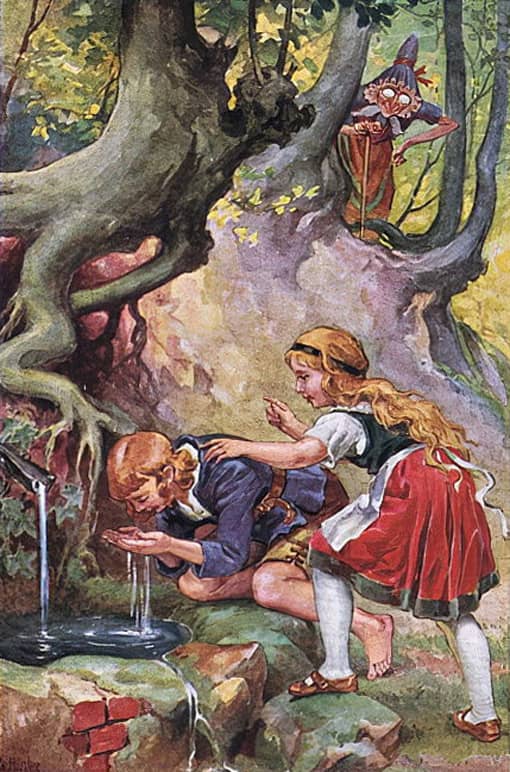 Image: George Hinke (1883 – 1953)
Image: George Hinke (1883 – 1953)Then she untied her golden girdle and bound it round the fawn’s neck, and went and gathered rushes to make a soft cord, which she fastened to him; and then she led him on, and they went deeper into the forest. And when they had gone a long long way, they came at last to a little house, and the maiden looked inside, and as it was empty she thought, „We might as well live here.“ And she fetched leaves and moss to make a soft bed for the fawn, and every morning she went out and gathered roots and berries and nuts for herself, and fresh grass for the fawn, who ate out of her hand with joy, frolicking round her.
At night, when the sister was tired, and had said her prayers, she laid her head on the fawn’s back, which served her for a pillow, and softly fell asleep. And if only the brother could have got back his own shape again, it would have been a charming life. So they lived a long while in the wilderness alone. Now it happened that the King of that country held a great hunt in the forest. The blowing of the horns, the barking of the dogs, and the lusty shouts of the huntsmen sounded through the wood, and the fawn heard them and was eager to be among them.
„Oh,“ said he to his sister,“ do let me go to the hunt. I cannot stay behind any longer,“ and begged so long that at last she consented. „But mind,“ said she to him,“ come back to me at night. I must lock my door against the wild hunters, so, in order that I may know you, you must knock and say, ‚ Little sister, let me in,‘ and unless I hear that I shall not unlock the door.“ Then the fawn sprang out, and felt glad and merry in the open air. The King and his huntsmen saw the beautiful animal, and began at once to pursue him, but they could not come within reach of him, for when they thought they were certain of him he sprang away over the bushes and disappeared.
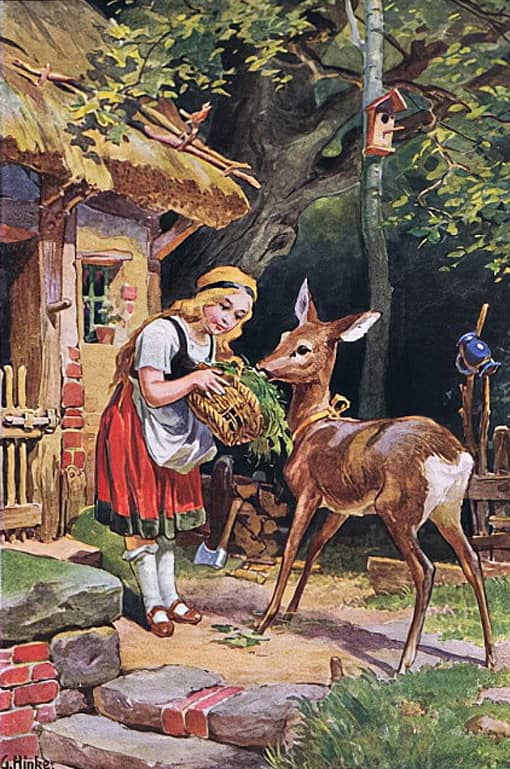 Image: George Hinke (1883 – 1953)
Image: George Hinke (1883 – 1953)As soon as it was dark he went back to the little house, knocked at the door, and said, „Little sister, let me in.“ Then the door was opened to him, and he went in, and rested the whole night long on his soft bed. The next morning the hunt began anew, and when the fawn heard the hunting-horns and the tally-ho of the huntsmen he could rest no longer, and said, „Little sister, let me out, I must go“. The sister opened the door and said, „Now, mind you must come back at night and say the same words.“ When the King and his hunters saw the fawn with the golden collar again, they chased him closely, but he was too nimble and swift for them.
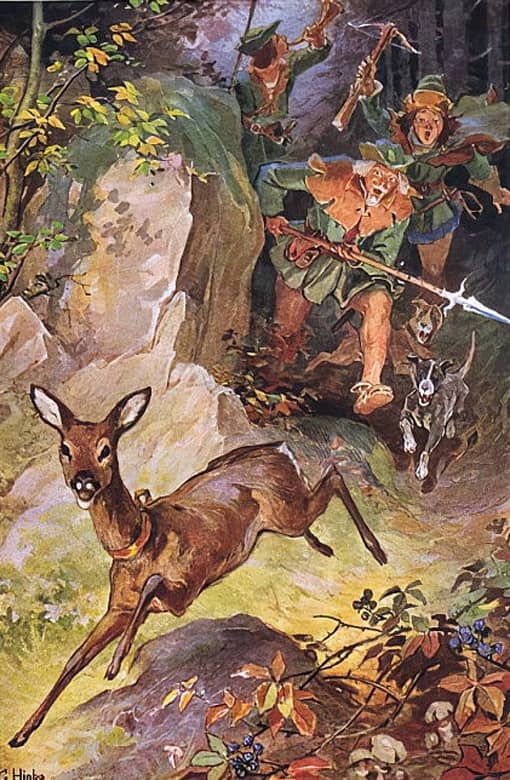 Image: George Hinke (1883 – 1953)
Image: George Hinke (1883 – 1953)This lasted the whole day, and at last the hunters surrounded him, and one of them wounded his foot a little, so that he was obliged to limp and to go slowly. Then a hunter slipped after him to the little house, and heard how he called out,“ Little sister, let me in,“ and saw the door open and shut again after him directly., The hunter noticed all this carefully, went to the King, and told him all he had seen and heard. Then said the King, „To-morrow we will hunt again.“
But the sister was very terrified when she saw that her fawn was wounded. She washed his foot, laid cooling leaves round it, and said,“ Lie down on your bed, dear fawn, and rest, that you may be soon well.“ The wound was very slight, so that the fawn felt nothing of it the next morning. And when he heard the noise of the hunting outside, he said, „I cannot stay in, I must go after them. I shall not be taken easily again!“
The sister began to weep, and said, „I know you will be killed, and I left alone here in the forest, and forsaken of everybody. I cannot let you go!“ – „Then I shall die here with longing,“ answered the fawn“, when I hear the sound of the horn I feel as if I should leap out of my skin.“ Then the sister, seeing there was no help for it, unlocked the door with a heavy heart, and the fawn bounded away into the forest, well and merry.
When the King saw him, he said to his hunters, „Now, follow him up all day long till the night comes, and see that you do him no hurt.“ So as soon as the sun had gone down, the King said to the huntsmen:“ Now, come and show me the little house in the wood.“ And when he got to the door he knocked at it, and cried, „Little sister, let me in!“ Then the door opened, and the King went in, and there stood a maiden more beautiful than any he had seen before. The maiden shrieked out when she saw, instead of the fawn, a man standing there with a gold crown on his head.
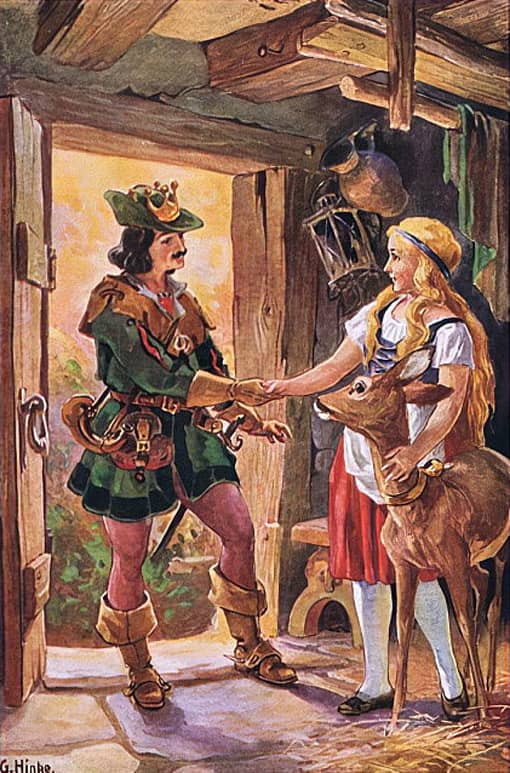 Image: George Hinke (1883 – 1953)
Image: George Hinke (1883 – 1953)But the King looked kindly on her, took her by the hand, and said, „Will you go with me to my castle, and be my dear wife?“ – „Oh yes,“ answered the maiden, „but the fawn must come too. I could not leave him.“ And the King said, „He shall remain with you as long as you live, and shall lack nothing.“ Then the fawn came bounding in, and the sister tied the cord of rushes to him, and led him by her own hand out of the little house.
The King put the beautiful maiden on his horse, and carried her to his castle, where the wedding was held with great pomp. So she became lady Queen, and they lived together happily for a long while. The fawn was well tended and cherished, and he gambolled about the castle garden.
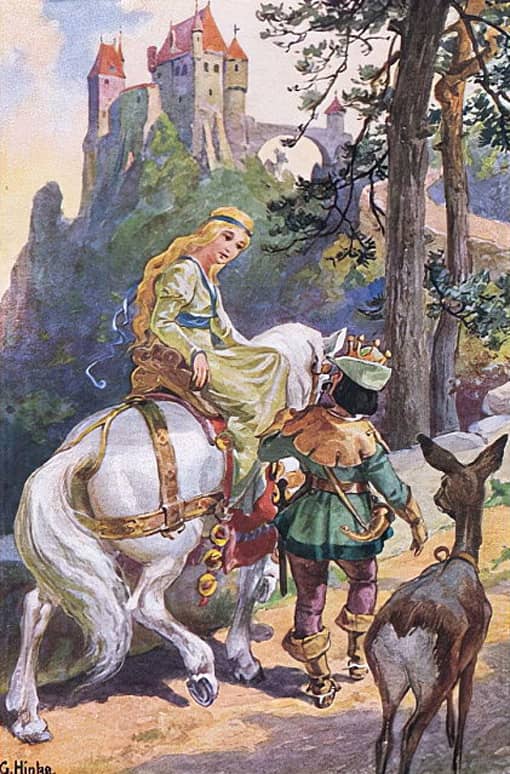 Image: George Hinke (1883 – 1953)
Image: George Hinke (1883 – 1953)Now the wicked stepmother, whose fault it was that the children were driven out into the world, never dreamed but that the sister had been eaten up by wild beasts in the forest, and that the brother, in the likeness of a fawn, had been slain by the hunters. But when she heard that they were so happy, and that things had gone so well with them, jealousy and envy arose in her heart, and left her no peace, and her chief thought was how to bring misfortune upon them. Her own daughter, who was as ugly as sin, and had only one eye, complained to her, and said, „I never had the chance of being a Queen.“
„Never mind,“ said the old woman, to satisfy her. „When the time comes, I shall be at hand.“ After a while the Queen brought a beautiful baby-boy into the world, and that day the King was out hunting. The old witch took the shape of the bedchamber woman, and went into the room where the Queen lay, and said to her, „Come, the bath is ready. It will give you refreshment and new strength. Quick, or it will be cold.“ Her daughter was within call, so they carried the sick Queen into the bath-room, and left her there. And in the bath-room they had made a great fire, so as to suffocate the beautiful young Queen.
When that was managed, the old woman took her daughter, put a cap on her, and laid her in the bed in the Queen’s place, gave her also the Queen’s form and countenance, only she could not restore the lost eye. So, in order that the King might not remark it, she had to lie on the side where there was no eye. In the evening, when the King came home and heard that a little son was born to him, he rejoiced with all his heart, and was going at once to his dear wife’s bedside to see how she did. Then the old woman cried hastily, „For your life, do not draw back the curtains, to let in the light upon her. She must be kept quiet.“ So the King went away, and never knew that a false Queen was lying in the bed.
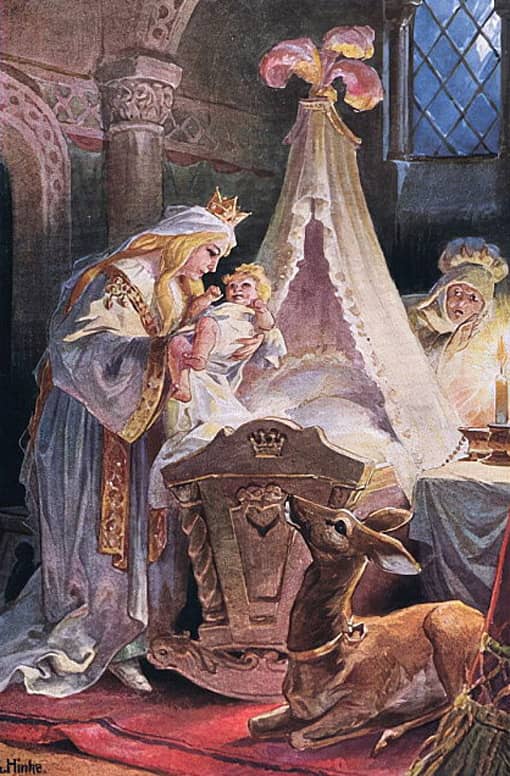 Image: George Hinke (1883 – 1953)
Image: George Hinke (1883 – 1953)Now, when it was midnight, and every one was asleep, the nurse, who was sitting by the cradle in the nursery and watching there alone, saw the door open, and the true Queen come in. She took the child out of the cradle, laid it in her bosom, and fed it. Then she shook out its little pillow, put the child back again, and covered it with the coverlet. She did not forget the fawn either: she went to him where he lay in the corner, and stroked his back tenderly.
Then she went in perfect silence out at the door, and the nurse next morning asked the watchmen if any one had entered the castle during the night, but they said they had seen no one. And the Queen came many nights, and never said a word. The nurse saw her always, but she did not dare speak of it to any one. After some time had gone by in this manner, the Queen seemed to find voice, and said one night,
„My child my fawn twice more I come to see.
Twice more I come, and then the end must be.“
The nurse said nothing, but as soon as the Queen had disappeared she went to the King and told him all. The King said, „Ah, heaven! what do I hear! I will myself watch by the child to-morrow night.“ So at evening he went into the nursery, and at midnight the Queen appeared, and said,
„My child my fawn once more I come to see.
Once more I come, and then the end must be.“
And she tended the child, as she was accustomed to do, before she vanished. The King dared not speak to her, but he watched again the following night, and heard her say,
„My child my fawn this once I come to see.
This once I come, and now the end must be.“
Then the King could contain himself no longer, but rushed towards her, saying, „You are no other than my dear wife!“ Then she answered, „Yes, I am your dear wife,“ and in that moment, by the grace of heaven, her life returned to her, and she was once more well and strong. Then she told the King the snare that the wicked witch and her daughter had laid for her.
The King had them both brought to judgment, and sentence was passed upon them. The daughter was sent away into the wood, where she was devoured by the wild beasts, and the witch was burned, and ended miserably. And as soon as her body was in ashes the spell was removed from the fawn, and he took human shape again. And then the sister and brother lived happily together until the end.
 Learn languages. Double-tap on a word.Learn languages in context with Childstories.org and Deepl.com.
Learn languages. Double-tap on a word.Learn languages in context with Childstories.org and Deepl.com.Backgrounds to fairy tale „Little Brother and Little Sister“
„Little Brother and Little Sister“ (also known as „Brüderchen und Schwesterchen“ in German) is a fairy tale collected by the Brothers Grimm in their collection „Children’s and Household Tales“, which was first published in 1812. This tale is known as number 11 in their collection and has its origins in German folklore. The story revolves around a little brother and sister who flee from their wicked stepmother, who is also a witch. The stepmother has made life unbearable for them, and they decide to escape into the woods. As they wander through the forest, the stepmother follows them, casting spells on the streams they encounter, which turn into poison or wine. The sister, being cautious, keeps her brother from drinking the enchanted water.
Eventually, they come across a stream that their stepmother hasn’t yet enchanted. The brother, extremely thirsty, drinks from it, but the water turns him into a deer. Despite this transformation, the brother and sister continue their journey, eventually finding an empty cottage in the woods. They decide to live there, with the sister caring for her deer brother and keeping him safe. One day, a king goes hunting in the forest and discovers the deer. The deer (the brother) manages to escape, and the king follows him back to the cottage. The king meets the sister, and they fall in love. They marry, and the sister becomes queen. The deer brother continues to live with them in the castle.
The wicked stepmother, learning about their happiness, decides to take revenge. Disguised as an old woman, she visits the queen and gives her a poisoned shirt as a gift. When the queen touches the shirt, she falls into a death-like sleep. The stepmother then disguises herself as the queen, fooling everyone except the deer brother. The king eventually discovers the truth and burns the stepmother alive. As she dies, the spell on the brother is broken, and he transforms back into a human. The queen awakens from her sleep, and they all live happily ever after.
„Little Brother and Little Sister“ is a classic example of a Brothers Grimm fairy tale, containing elements of magic, transformation, good versus evil, and a happy ending. The story emphasizes the strong bond between siblings, the importance of resilience, and the ultimate triumph of good over evil. The tale has been retold and adapted in various forms, including books, plays, and films, and remains popular as a story that teaches the value of family and loyalty. The tale explores themes of family bonds, love, the struggle between good and evil, and the triumph of resilience and bravery in the face of adversity. Like many other Grimm fairy tales, „Little Brother and Little Sister“ has a moral undertone, emphasizing the importance of loyalty, kindness, and determination.
The Brothers Grimm, Jacob and Wilhelm, were German academics and linguists who dedicated their lives to preserving traditional stories and folklore. They collected tales from various sources, including oral accounts from storytellers, written manuscripts, and other collectors‘ works. The backgrounds of these stories often reflect the cultural and social context of the time, including the difficulties faced by common people and the importance of morality in their lives. The tales in their collection were influenced by the local customs. Their work aimed to preserve Germanic folklore and promote national identity in a time of cultural and political change.
„Brother and Sister“ is a European fairy tale and is classified as an Aarne-Thompson Type 450 tale. The story’s origin traces back to Giambattista Basile’s Pentamerone in the 17th century. The tale is also known as „Little Sister and Little Brother“ and „Sister Alionushka, Brother Ivanushka“ in Russia.
Interpretations to fairy tale „Little Brother and Little Sister“
„Little Brother and Little Sister“ from Brothers Grimm is a rich tale that can be interpreted in various ways. Here are some possible interpretations and themes that can be drawn from this classic fairy tale:
The power of family bonds: The story emphasizes the strong bond between the brother and sister, who stick together through hardships and adversities. Their love and loyalty to each other help them overcome the wicked stepmother’s schemes, demonstrating the importance of family ties. The story highlights the strong bond between the siblings, who support and protect each other throughout their journey. The sister’s unwavering loyalty to her brother, even when he becomes a fawn, demonstrates the importance of family ties and the lengths one would go to protect their loved ones.
The power of love and kindness: The sister’s kindness towards her brother and the fawn plays a crucial role in their survival and eventual happiness. Her gentle and caring nature contrasts sharply with the wickedness of the stepmother and stepsister, emphasizing the transformative power of love and kindness over cruelty and malice.
The consequences of greed and envy: The wicked stepmother’s jealousy and envy lead her to cast evil spells on her stepchildren, causing them great suffering. However, her actions ultimately bring about her own downfall. This interpretation serves as a cautionary tale about the negative consequences of letting greed and envy consume one’s actions.
Transformation and redemption: The story also explores themes of transformation and redemption. The brother’s transformation into a fawn symbolizes his vulnerability and innocence, while the sister’s selfless love and care allow them to survive and eventually find happiness. The King’s love for the sister also plays a role in breaking the stepmother’s spells and restoring their true selves, highlighting the power of love and forgiveness in overcoming adversity.
Good versus evil: The tale features a clear struggle between good (the brother and sister) and evil (the wicked stepmother). The siblings‘ goodness and perseverance eventually lead to their triumph over the evil stepmother. This theme is a common one in many fairy tales, offering a moral lesson about the ultimate triumph of good over evil. Despite the challenges and obstacles the siblings face, they ultimately prevail over the wicked stepmother’s schemes. The story conveys the message that good will eventually triumph over evil, even in the face of seemingly insurmountable odds.
Resilience and determination: The brother and sister face numerous challenges throughout their journey, including the stepmother’s attempts to harm them, the brother’s transformation into a deer, and the queen’s enchanted sleep. Despite these obstacles, they remain resilient and determined, eventually overcoming their difficulties and achieving happiness.
The transformative power of love: The love between the brother and sister is a transformative force in the story, providing them with the strength to overcome the stepmother’s evil schemes. Additionally, the king’s love for the sister also plays a crucial role in the story, as it ultimately leads to their union and the restoration of the brother’s human form.
Caution and wisdom: The sister’s caution and wisdom save her brother from drinking the enchanted water, illustrating the importance of being careful and thoughtful in challenging situations. This can be seen as a lesson for readers to think critically and not rush into potentially dangerous situations.
The consequences of greed and envy: The wicked stepmother’s actions are driven by her jealousy and greed, which ultimately lead to her downfall. This theme serves as a cautionary tale about the negative consequences of allowing envy and selfishness to guide one’s actions.
The tale has been interpreted from historical and psychological perspectives. Historically, it has been seen as a wish for the return of brothers who were sent away as soldiers, freeing their sisters from parental control over their marriages. Psychologically, the relationship between the brother and sister represents the animalistic and spiritual duality in humans, with the brother as the instinctive side and the sister as the rational side. The story also conveys messages about family fidelity through adversity and separation. Overall, „Little Brother and Little Sister“ offers multiple interpretations and themes, providing valuable lessons about the importance of family, love, resilience, caution, and the ultimate triumph of good over evil.
Adaptions of the fairy tale „Little Brother and Little Sister“
„Little Brother and Little Sister,“ also known as „Brother and Sister,“ is a classic German fairy tale by the Brothers Grimm. Over the years, it has been adapted and reinterpreted in various forms of media. Here are some examples of adaptations of this timeless tale:
Books and Illustrated Editions: Several versions of the tale have been published with new illustrations and adaptations in the text. For example, „Brother and Sister“ by Jane Ray is a beautifully illustrated picture book that retells the story for a younger audience. „The Grimm Conclusion“ (2013) – A novel by Adam Gidwitz, which retells and interweaves various Grimm fairy tales, including „Little Brother and Little Sister.“ The book is part of the „A Tale Dark & Grimm“ series, which is known for its dark humor and unique narrative style. The tale has been adapted into numerous children’s books, including „Little Brother and Little Sister and Other Tales“ by the Grimm brothers themselves, as well as „The Enchanted Forest Chronicles“ by Patricia C. Wrede, which features characters inspired by the tale.
Animation and Film: Animated adaptations of the story have been created for children’s entertainment. One example is „Brother and Sister,“ a 1985 episode of the animated television series „Grimm’s Fairy Tale Classics.“ This adaptation stays true to the original story while adding some elements to make it suitable for a TV audience. „Hänsel und Gretel“ (1954) – A German live-action film directed by Walter Janssen, which adapts the story of „Little Brother and Little Sister“ alongside the more famous fairy tale „Hansel and Gretel.“ This film weaves the two stories together, with the siblings embarking on a journey that includes elements from both tales. „Grimm’s Fairy Tale Classics“ (1987-1989) – A Japanese animated television series that adapted various Grimm fairy tales, including „Little Brother and Little Sister“ in the episode titled „The Wishing-Table, The Gold-Ass, and The Cudgel in the Sack.“ This adaptation stays faithful to the original story, with a few tweaks for the animated format. There have been several film adaptations of the tale, including the 1953 East German film „Brüderchen und Schwesterchen“, and the 2003 animated film „The Adventures of Little Brother and Little Sister“. The story has also been adapted for television, including an episode of the popular British children’s show „Jackanory“ in 1969, and a 1982 episode of the American animated series „Faerie Tale Theater“.
Theater and Dance: The story has been adapted for the stage in various forms, including plays, ballets, and musicals. For example, „Little Brother and Little Sister: A Grimm’s Fairy Tale“ is a stage play by Max Bush that reimagines the story for a modern audience while preserving the essence of the original tale. „Little Brother, Little Sister“ (2016) – A stage adaptation by playwright John Thierwechter, which stays true to the original tale while incorporating modern elements and dialogue. This play was performed by community theaters and schools, providing a fresh take on the beloved fairy tale for contemporary audiences. The story has also been adapted for the stage, including a 2009 production by the National Theater in London, which featured puppets and live actors.
Radio and Audio Dramas: The fairy tale has also been adapted for radio and audio dramas. The BBC produced an adaptation of „Little Brother and Little Sister“ as part of their „Radio Tales“ series, which brought classic fairy tales to life in a dramatic audio format. In 2022, a musical adaptation of „Little Brother and Little Sister“ premiered in Los Angeles, featuring original songs and choreography.
These adaptations have often added their own unique twists and interpretations to the original tale, while still retaining the themes of family, survival, and perseverance. The tale has been adapted and retold in various forms, including literature, theater, and film, demonstrating its enduring appeal and relevance. Like many other Grimm’s fairy tales, „Little Brother and Little Sister“ explores themes such as family bonds, the power of love, and the struggle between good and evil, making it a timeless story that continues to resonate with audiences today.
Summary of the plot
„Little Brother and Little Sister“ is a fairy tale collected by the Brothers Grimm, which tells the story of a brother and sister who escape their wicked stepmother and face various challenges along the way. The siblings flee into the woods to escape their cruel stepmother, who is also a witch. She follows them and casts spells on the streams they come across, turning the water into poison or wine. The sister’s caution prevents her brother from drinking the enchanted water. However, when they find a stream that hasn’t been enchanted yet, the brother drinks from it, and the stepmother’s spell turns him into a deer.
Despite the transformation, the siblings continue their journey and find an empty cottage in the woods. They decide to live there, with the sister taking care of her deer brother. One day, a king goes hunting in the forest and discovers the deer. The deer leads the king back to the cottage, where he meets the sister. They fall in love, and the sister becomes the queen, while the deer brother continues living with them in the castle.
The wicked stepmother learns about their happiness and decides to take revenge. Disguised as an old woman, she visits the queen and gives her a poisoned shirt, which puts her into a death-like sleep. The stepmother then disguises herself as the queen, but the deer brother is not fooled. Eventually, the king uncovers the truth and burns the stepmother alive. As she dies, the spell on the brother is broken, and he turns back into a human. The queen awakens, and they all live happily ever after.
Abstract
The story of „Little Brother and Little Sister“ follows the journey of a brother and sister who run away from their wicked stepmother. The stepmother, envious of their close relationship, uses witchcraft to turn the brother into a fawn. Despite this, the sister remains loyal to her brother and cares for him. The pair eventually find refuge in a king’s castle, where the sister marries the king. However, the stepmother and stepsister continue to plot against them. The story concludes with the defeat of the wicked stepmother and the transformation of the brother back into a human, signifying the triumph of love, loyalty, and goodness over evil.
„Little Brother and Little Sister“ is a fairy tale by Brothers Grimm that tells the story of a brother and sister who flee from their wicked stepmother into the forest. The stepmother, a witch, curses the forest’s brooks, causing the brother to be transformed into a fawn after drinking from one of them. The sister takes care of the fawn, and they live together in a small house in the forest. One day, the King discovers the siblings and falls in love with the sister. They marry, and the fawn stays with them at the castle. However, the wicked stepmother learns of their happiness and plots to bring misfortune upon them. She tricks the Queen into entering a scorching bath, intending to suffocate her. The stepmother then places her ugly one-eyed daughter in the Queen’s bed, disguising her to look like the Queen.
At night, the true Queen secretly visits her child and the fawn, and eventually regains her voice to speak a haunting rhyme foretelling the end. The King, having been informed of these nightly visits, watches the Queen and eventually confronts her. The wicked stepmother’s spells are broken, the brother regains his human form, and the stepmother and her daughter are punished. The brother, sister, and King live happily ever after, cherishing the fawn as a reminder of their incredible journey.
Informations for scientific analysis
Fairy tale statistics | Value |
|---|---|
| Number | KHM 11 |
| Aarne-Thompson-Uther-Index | ATU Typ 450 |
| Translations | DE, EN, DA, ES, FR, PT, FI, HU, IT, JA, NL, PL, RO, RU, TR, TR, VI, ZH |
| Readability Index by Björnsson | 29.1 |
| Flesch-Reading-Ease Index | 83.1 |
| Flesch–Kincaid Grade-Level | 7 |
| Gunning Fog Index | 9.5 |
| Coleman–Liau Index | 6.7 |
| SMOG Index | 7.4 |
| Automated Readability Index | 7.3 |
| Character Count | 12.204 |
| Letter Count | 9.251 |
| Sentence Count | 113 |
| Word Count | 2.415 |
| Average Words per Sentence | 21,37 |
| Words with more than 6 letters | 187 |
| Percentage of long words | 7.7% |
| Number of Syllables | 2.914 |
| Average Syllables per Word | 1,21 |
| Words with three Syllables | 60 |
| Percentage Words with three Syllables | 2.5% |
















